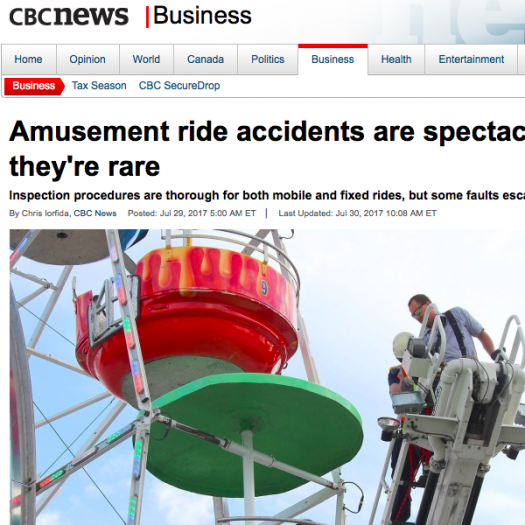Happy to provide information and quotes for this good effort by CBC to provide a balanced report.
“Amusement ride accidents are spectacular, but experts say they’re rare”.
As some supplementary commentary on the report, we have no national Canadian database, nor does the USA. Attractions report injuries and ridership to the International Association of Amusement Parks and Attractions, which concludes that injuries occur in one per 16 million rides taken. The source data is retained by each park, so no further overall analysis (such as the nature of the failures involved) can be made by others. Most analysis uses Consumer Product Safety Commission (CPSC) data.
CPSC estimates for U.S. national prevalence of amusement ride injuries may be overstated by 40%. When I analysed individual data points from this database for the year 2010, I found that total national estimate for “amusement ride injuries” was 22,520, but reviewing the individual data points, only 13,770 (61%) of them seemed to actually be other types of attractions rather than rides. Some of the included devices were mis-classified playground equipment, waterpark attractions, trampolines and other gymnastic equipment, and go karts. Other devices mentioned in some reports included ball pits, obstacle courses, swan boats, games, laser tag, haunted houses/corn mazes, and mechanical horses in shopping centres and mechanical bulls in bars that were correctly coded as “amusement attractions (including rides)” but should really be a separate classification. If I want to evaluate my risk of being harmed by mechanical failure when I get on a Ferris wheel or roller coaster, I don’t need to factor in the incidence of people tripping and falling their way through various walkthrough attractions.
Another criticism of this estimate for ride injuries is the source data. Because CPSC data is extrapolated from a network of 100 ERs that participate in the National Electronic Injury Surveillance System (NEISS). It is debatable whether the dispersal of these sites across the USA is as representative for something like amusement parks as they are for consumer products like toasters and lawnmowers, and even CPSC has acknowledged this in their own past reports.)
If you are interested in which US states have regulatory oversight of rides, check this page from Saferparks.

